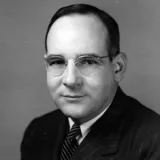
John Schoff Millis became president of the University of Vermont on November, 3, 1941, exactly one hundred and fifty years to the day after the signing of the original charter. It was a depressing, ominous time. UVM was more than half a million dollars in debt, and events were going so badly in World War II that is seemed inevitable that the United States would become involved. Two days after his inauguration, thirty-seven-year-old Millis wrote to his father, ‘I know I have bitten off a fairly sizeable bite, but I am hopeful that I can handle it without killing myself. Time will provide the answer and at present, I’m on the job.”
John Millis was born on November 22, 1903 in Palo Alto, California. His father was a well-known professor in economics at the University of Chicago where Millis received his bachelor’s degree in 1924, a Master of Science degree in 1927, and a Ph.D. degree in physics in 1931. He married Katherine Roseberry Wesner in 1929, the same year he accepted a position as an assistant professor of physics at Lawrence College in Wisconsin. Moving rapidly up the ranks, Millis was promoted to full professor in 1934, dean of the college in 1936, and dean of administration in 1939. In 1940, he was awarded a Carnegie Corporation grant to travel around the country, studying the management of colleges and universities. As a result of this project, the young administrator was recommended as the individual who could straighten out the financial and managerial problems of which the University of Vermont faced.
Just two months before Millis arrived in Burlington, the Vermont legislature has been called into special session by the Governor William H. Wills to deal with the university’s financial crisis. On September 16, a day before UVM’s fall term opening, the legislature approved a “rescue plan,” appropriating $260,000 in support for the next fiscal year to be matched by alumni contributions. In addition, the legislature stipulated that the university must set aside $68,880, each year, to cover interest on its outstanding debt. Although the legislature was called to focus solely on the university’s needs, once it was in special session it decided to use the occasion to declare war on Nazi Germany (the term it used was “a state of belligerency”), thus providing official notice to Adolph Hitler that he was persona non grate so far as the state of Vermont was concerned.
One month after Millis began his presidency, the Japanese attacked Pearl Harbor and the United States entered the war. Large numbers of students left the university to enlist in the military services, and the total number of undergraduates dropped drastically from 1,300 to 650 within only two years. As a result, UVM arranged to bring U.S. Air Force training units to campus for special six-to-eight-week courses to help make up for the lost tuition revenues.
The war years were trying times of sacrifice and financial austerity. A top priority was the security fund drive to raise money from alumni and friends to match the legislative appropriations. Proctor Page, a banker from Burlington, was appointed to serve as UVM’s treasurer, and Millis and the trustees devoted their major energies to monitoring the financial situation. In addition, Millis pushed through a number of other important reforms during the war years, including a plan that guaranteed academic freedom and tenure for the faculty, as well as a university retirement plan.
As soon as the war ended, UVM was flooded with returning students, and enrollment jumped to more than two thousand in fifteen months. In 1946, Millis reorganized the university into five divisions—Arts and Sciences, Medicine, Agriculture, Education, and Nursing, and a new College of Technology for engineering, mathematics, chemistry, economics, and business. President Millis stayed on for three more years to manage the postwar transition.
A strapping six-foot-plus man, Millis was active in the local Episcopal church where he served as lay reader. He was extremely capable and forceful, full of drive and vigor, but he could be brusque, demanding, and autocratic. His wife, Kay, was very outgoing.
In 1949 John S. Millis resigned from UVM to become president of Western Reserve University in Cleveland, Ohio. He was later named Chancellor of Case Western Reserve University, a position he held until 1969. Following his retirement, he chaired the National Fund for Medical Education, and he also served on the National Board of Medicine Examiners.
The Millis family retained their ties with the university after they moved to Ohio. Both daughters attended UVM and for many years, the entire family spent vacations at their camp in Shelburne Bay. On January 1, 1988, John Millis died in Cleveland Heights, Ohio, at the age of eighty-four. He was survived by his wife, a son, and two daughters.
During his term at UVM, President Millis provided steady leadership through demanding times. He reduced the university deficit by more than $420,000, and restored the institution’s financial health. He initiated a number of important academic and curricular reforms, and he presided over the postwar enrollment expansion, which involved planning the addition of fourteen new buildings. During this latter period, the dormitory plant more than tripled following the construction of Buckham, Chittenden, Wills, and Coolidge halls; the University Heights complex was built to help house the faculty; the state provided funds to build Hills Agricultural Science Hall and the Dairy Science Building.
In terms of his overall contributions, John Millis ranks as another of those uniquely qualified individuals who provided precisely the right type of leadership the university needed during a very trying period. As a result of his presidency, UVM emerged as a rejuvenated and stronger institution.